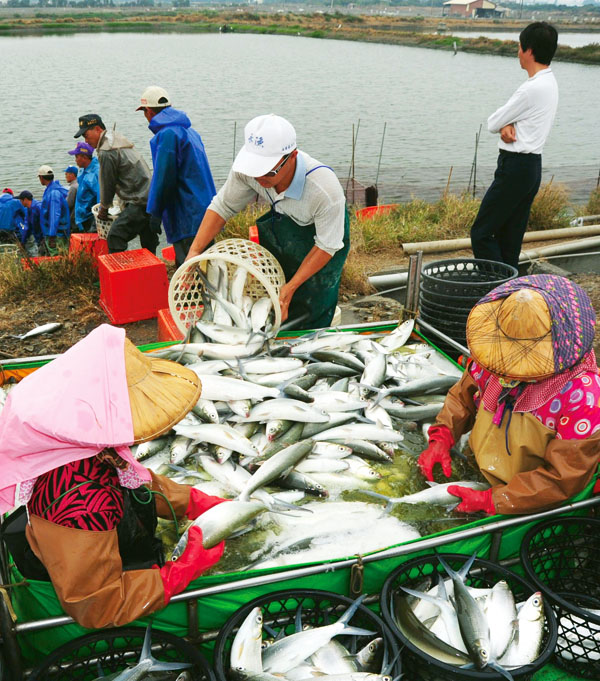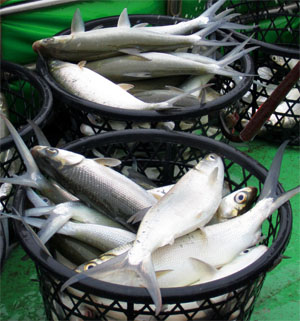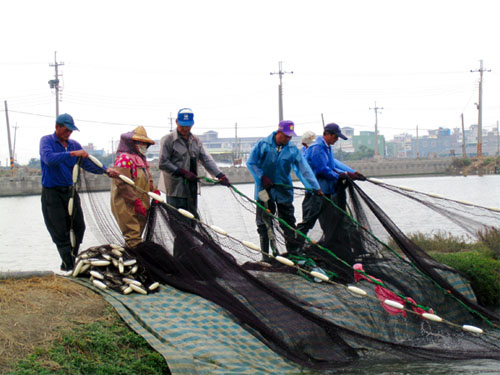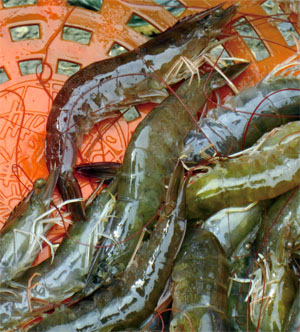Milkfish Aquaculture in Kaohsiung / 虱目魚產業
Milkfish Aquaculture in Kaohsiung
◎English written by Peng Hsin-yi
◎Photos by Pao Chung-hui, Yang Chan-hua, Hou Ya-ting
 Yongan District is famous for its aquaculture, producing nearly a quarter of Taiwan's farmed grouper. Yongan's milkfish farms occupy approximately 400 hectares, a greater land mass than that of grouper farms. Neighboring Mito District and Yongan have come together as Kaohsiung's largest milkfish supplier.
Yongan District is famous for its aquaculture, producing nearly a quarter of Taiwan's farmed grouper. Yongan's milkfish farms occupy approximately 400 hectares, a greater land mass than that of grouper farms. Neighboring Mito District and Yongan have come together as Kaohsiung's largest milkfish supplier.
It is not easy to maintain a fish farm. Costs are constantly on the rise with increasing corn and grain prices that are essential for fish feed. Utilities and other expenses have also become considerably more expensive. In order to improve their economic status, they now also farm ridge-tail prawns alongside milkfish, in order to generate additional income.
Yongan's milkfish ponds are meticulously kept and filled with both saltwater and freshwater. Seawater is constantly pumped in from the ocean with pipes that are up to 2 or 3 kilometers long. Milkfish matures in approximately six months. They are small and slimy during the winter months, with little appetite when the weather is cold. During the rainy season the mixture of freshwater and saltwater becomes more nutritious and the fish grow quickly, reaching maturity at 1 to 1.5 Taiwan catties (600 to 900 grams). Yongan's milkfish is flavorful and has a firm texture. It is extremely popular, with peak season being between July and October. They are distributed to fish markets throughout Taiwan. Some major markets include Gangshan in Kaohsiung and other wholesalers in Tainan, Chiayi and Taipei.
 The fish farmers explain that although milkfish is easy to manage, cold weather is always a hazard. Milkfish has a low tolerance for coldness and if the temperature drops to minus 6 degrees Celsius, the whole crop will die. It is an industry that is entirely at the mercy of nature.
The fish farmers explain that although milkfish is easy to manage, cold weather is always a hazard. Milkfish has a low tolerance for coldness and if the temperature drops to minus 6 degrees Celsius, the whole crop will die. It is an industry that is entirely at the mercy of nature.
※The Harvest
The harvest is hard, and manual labor requires a whole team of fish farmers who work with efficient and experienced precision. Famers first lower a gigantic circular shaped net into the pond. They then position themselves around the net at regular intervals and with gentle, subtle movements, they start pulling. They bend their bodies backwards to counter the weight of the water. They then slowly tighten the net and round up the fish into a small square. The fish is then transferred to larger baskets with a relay line, to a smaller pool on shore and separated by weight into different baskets. The baskets are weighed and the fish is placed into Styrofoam boxes filled with ice and taken to market. The farmers make the process look so easy, the years of practice is evident. Yongan is impressive, not only because of its beautiful, robust milkfish, but also the devoted lifestyle of the residents.
虱目魚產業
◎文/侯雅婷
◎攝影/鮑忠暉.楊蟬華.侯雅婷
 走在永安區的魚塭小徑、甚至民宅旁的小水溝邊,地上不時可見盤據一處的虱目魚鱗片,風乾後的魚鱗片 ,散發出一種珍珠般的溫潤光澤,在陽光的折射下,靜靜地閃耀著,見證著永安區與養殖漁業密不可分的關係。
走在永安區的魚塭小徑、甚至民宅旁的小水溝邊,地上不時可見盤據一處的虱目魚鱗片,風乾後的魚鱗片 ,散發出一種珍珠般的溫潤光澤,在陽光的折射下,靜靜地閃耀著,見證著永安區與養殖漁業密不可分的關係。
永安區的石斑魚年產量佔全台四分之一,素有「石斑魚故鄉」的美譽,但永安虱目魚養殖面積卻大於石斑,約達400多公頃,永安區與鄰近的彌陀區同為高雄市大宗虱目魚養殖產業重鎮。
近年來在全球糧價高居不下,造成含玉米等穀類成分的魚飼料價格飆漲,再加上水電等開銷,虱目魚漁戶忍不住叫苦連天。為了提高飼養的經濟效益,漁戶採用「共池」的養殖方式,除了虱目魚還同時養殖白蝦,以增加收入。
永安區虱目魚為純海水養殖,漁戶直接接管海水,有時管線更長達2~3公里 。虱目魚飼養時間約6個月,天氣冷時 ,虱目魚胃口全失,特別瘦小,等到雨季來臨時,鹹水魚塭降下了豐沛的雨水 ,新鮮雨水與鹹水交互作用後,提供大量養份使虱目魚快速的成長。成年的虱目魚每尾約重1~1.5台斤,混和鹹、淡水養殖法,讓永安區虱目魚肉質特別香 、特別結實,格外受到市場歡迎。虱目魚的旺季為7~10月,永安區虱目魚的銷售管道主要販售至岡山魚市場、新營、嘉義和台北。
 漁民口中很容易飼養的虱目魚最怕寒害,只要氣溫降至6度,虱目魚就會凍斃,漁戶的辛苦也將付諸流水,若說虱目魚養殖戶是靠天吃飯一點也不為過。
漁民口中很容易飼養的虱目魚最怕寒害,只要氣溫降至6度,虱目魚就會凍斃,漁戶的辛苦也將付諸流水,若說虱目魚養殖戶是靠天吃飯一點也不為過。
※虱目魚的捕撈
虱目魚養殖戶在魚塭放下大網後,圈成一個圓形,現場彷彿有種無聲的節奏 ,岸上漁戶協力慢慢將魚網往上拉,身體自然呈現往後仰的姿勢,逐漸把魚網縮小,這是個極為講求技巧、默契的工作,且相當費力。漁戶將捕獲的虱目魚全部都趕進方型網子縮小範圍後,再裝在魚簍子以接力的方式,送到岸上小池裏,由人工以依重量分類。
分類好的魚簍子,漁戶用鐵勾子一鉤 ,順手就將魚簍子放在大磅秤上,之後直接放進裝有大量冰塊的保麗龍盒子保鮮,放到大卡車上,滿載虱目魚的卡車要載往北部。一連串的動作一氣呵成,令人屏氣凝神,在這裡讓人見識到漁戶的專業,還有一尾尾肥美超大虱目魚。